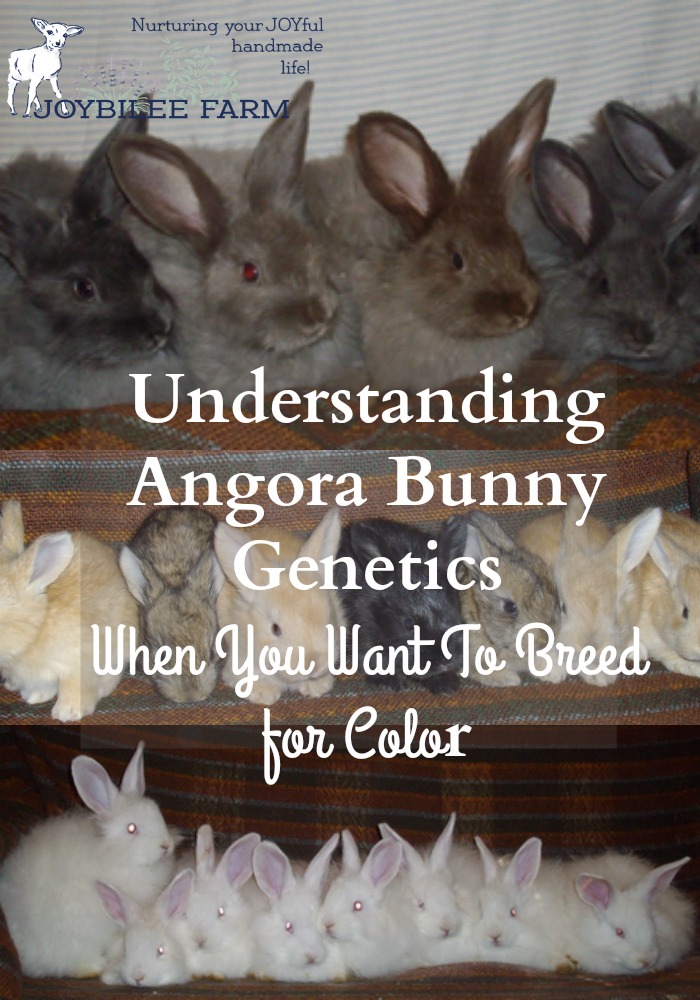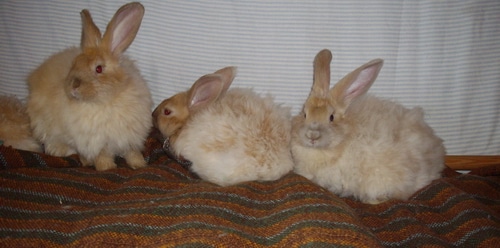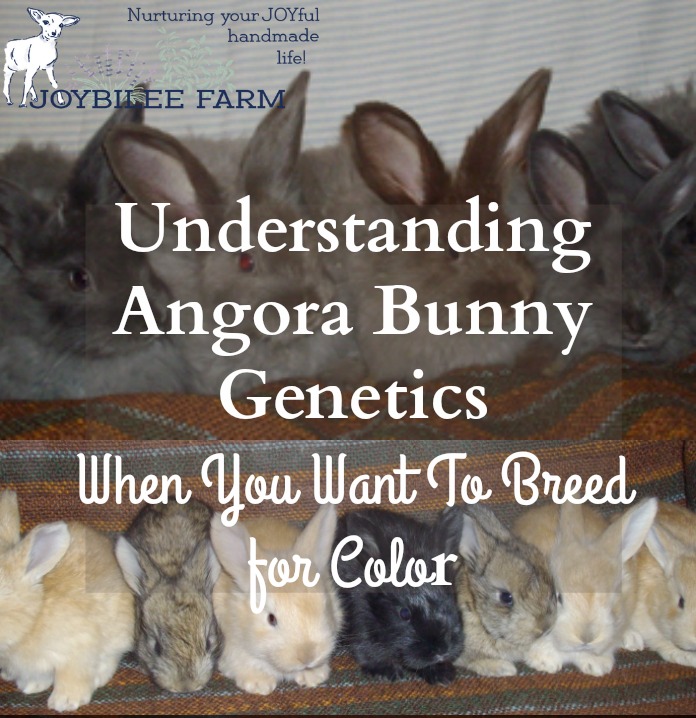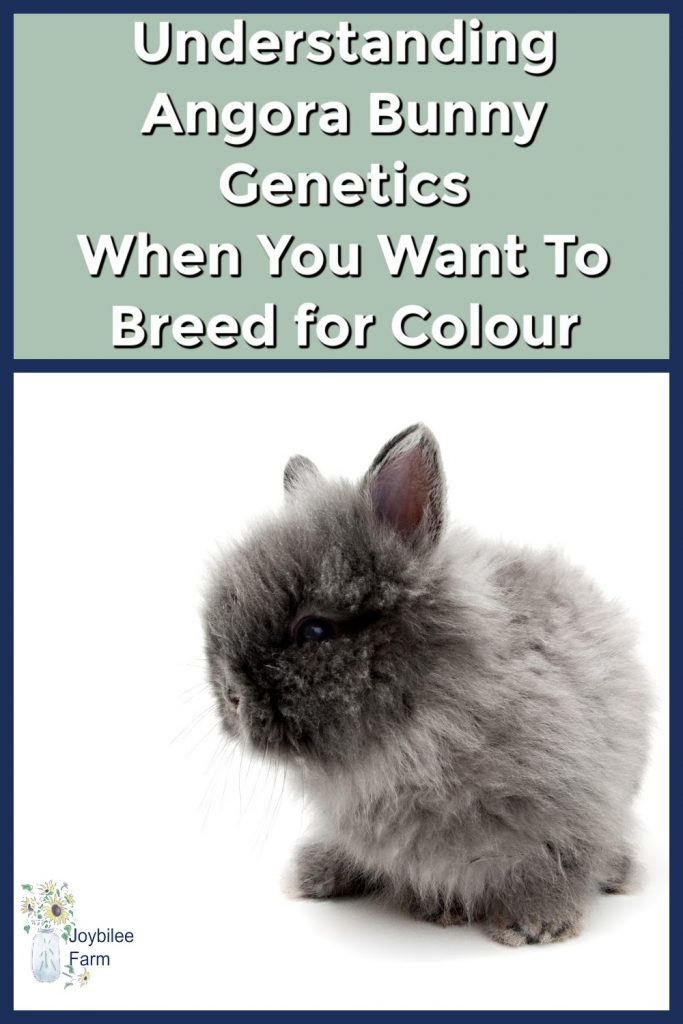Here’s what you need to know about Angora bunny genetics to keep your Angora colours strong, while still breeding for the choicest colours.
When breeding Angora rabbits for colour, on your homestead, you need to have an understanding of basic Angora bunny genetics in order to ensure that you maintain the colour choices in your herd of Angora rabbits. Allow only your favourite colours to be bred and in a few seasons, you may find yourself bereft of choice. For instance, I saved a lilac male for breeding. Lilac at the time was a choice colour and fairly rare, being a recessive gene and so I thought that by using this buck for breeding, I would ensure that I wouldn’t lose this colour to the more dominant chocolate genetics. However, lilac began to show up more and more in my breedings and after 3 years black and chocolate became difficult to get in a litter. Here’s what you need to know to keep your angora colours strong in your litters, while still breeding for the choicest colours in your French Angora rabbits.

Angora Bunny Genetics and Adult Colours
There are several ARBA approved angora colours and they can be clearly defined into three main groups: White, Self and Agouti.
Angora Bunny Genetics: White Rabbits – the albino gene
White (aka Ruby Eyed White or REW) carries an albino gene. This gene masks the genetic makeup of the carrier rabbit so that its fur is pure white and its eye irises are ruby coloured — actually transparent so that you can see the blood vessels in the eye. The albino rabbit (Ruby Eyed White) will transfer its genetic makeup to its off Spring so looking at its litter will give you clues to its genetic makeup — if unknown.
The albino gene is recessive so both parents must be carriers for the offspring to be REW. When a REW and a REW breed — 100% of the off Spring are REW.

Angora Bunny Genetics – Self Rabbits:
A self rabbit is a solid coloured rabbit — Its face, back and stomach are the same colour. There are two basic colours in rabbits – Black and Chocolate. These two colours can be diluted to Blue and Lilac, respectively.
Black is the dominant gene. Blue is a dilute gene of the Black. Chocolate is the other self colour — recessive to black– and lilac is the dilute gene of the chocolate.
In breeding, with a chocolate and lilac rabbit, only chocolate and lilac colours can result in either selfs or tortes.

Tortes have a shaded gene that expresses itself in self rabbits. They look golden or fawn but have the shading of their self genetics on the face, ears and flanks. The shading isn’t obvious until 4 to 6 weeks of age.
For the greatest variety in the nest box in self rabbits, breeding of a black rabbit with a lilac rabbit will give black, blue, chocolate, and lilac babies as well as tortes in these self colours, and ruby eyed whites.

This breeding gives the greatest variety of natural angora colours for handspun yarns too — fawn, white, charcoal and warm grey from one breeding.
Angora rabbits molt 4 times each year and release their wonderful warm fibre to be groomed from them. A french angora rabbit will provide approx. 450 grams of prime groomed angora fibre each year — enough for a shawl or light sweater.
This is part of a series of posts on Angora Rabbits 101:
Part 1 -When Fluffy Bunny Becomes Matted
Part 2 -6 steps to dealing with Sore hocks in your Angora Rabbits
Part 3 – Feeding your Angora Rabbits organically
Part 4 – Breeding for colour: Understanding Angora Bunny Genetics: The self rabbit
Part 5 – Angora Bunny Genetics: The wild rabbit colouring
Part 6 – Angora Bunny Genetics: The Shaded Gene




It depends on what is in the background of both but especially the white. If you have a pedigree check the colors of the parents of the white and then the colors of the line of the chocolate. If the chocolate has has white in the line you will get white. White is dominant. Your possibilities are all chocolate, all white or a mix of chocolate and white and anything thing that is in the background. Remember er that you see (called the phenotype, is not the real color of the rabbit according to its genetic makeup or genotype. You need more information to be able to predict for sure what you will get.
It depends on what is in the background of both but especially the white. If you have a pedigree check the colors of the parents of the white and then the colors of the line of the chocolate. If the chocolate has has white in the line you will get white. White is dominant. Your possibilities are all chocolate, all white or a mix of chocolate and white and anything thing that is in the background. Remember er that you see (called the phenotype, is not the real color of the rabbit according to its genetic makeup or genotype. You need more information to be able to predict for sure what you will get.
t
If you want quality fiber then don’t cross breed as it creates an unstable gene pool. Get a proper real angora of the same type and breed to the standard for the Satin . Particularly if you have Satin angoras – protect the lineage – they are becoming too rare and we are losing the heritage genetics and sheen . Learn about breeding and genetics and what is required for a good conformation and structure of the rabbit. Don’t breed indiscriminately just because you have another rabbit. Most import is not to cross them and breed to the standard . Be a responsible breeder. Angoras are bred for their beautiful fiber and when crossed you introduce all kinds of problems and create an unstable gene pool.